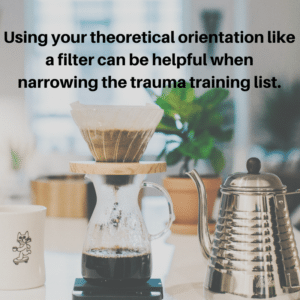This is an exciting time as a trauma therapist. There are new developments in our field on a daily basis. These new developments have led to an ever-growing list of treatment modalities and credentials. While this is great, it can be overwhelming at the same time. Especially whe n you are trying to decide what training to take and what credentials to pursue.
n you are trying to decide what training to take and what credentials to pursue.
On my niche journey, I discovered using my theoretical orientation as a filter is a great way to narrow the ever-growing list of trauma training and credentials. Below I will share two tips you can use to narrow your list using your theoretical orientation.
The Dreaded Theoretical Orientation Paper
In graduate school, I had to write the paper that described my theoretical orientation. I remember setting in the library, that was my favorite place to get things done, saying to myself, “I like them all.” I ended up settling on eclectic, which included Family Systems and Cognitive Behavioral. As the years have passed and my experience has grown, I have changed. I now ascribe to Psychodynamic, Family Systems, and Regulation Theories.
I found over the years, knowing my theoretical orientation was helpful as I started to really hone in on my niche as a trauma therapist. Finding training that fit my theoretical orientation helped me to narrow down the list and become more comfortable in my treatment of trauma survivors.
Two Tips
As I mentioned earlier, the list is growing in regards to trauma-focused training and credentials. There are so many ways to help our clients heal. Here are some tips in helping you narrow down the list of options as you niche in trauma therapy.
Tip #1 Clarify Your Theoretical Orientation: Knowing what theories inform the way you work provides clarity into who you are as a therapist and how you conceptualize your cases. I encourage you to take time to read about different theoretical orientations and either confirm what you already knew about yourself or potentially explore new possibilities. Some popular theoretical orientations are Cognitive Behavioral, Psychodynamic, Humanistic, Family Systems, Holistic/ Integrative, and Regulation. I found this fun little quiz that was created to help first-year graduate students identify their theoretical orientation. You can take it here.
Tip #2 Find Trauma Training and Credentials That Fit Your Theoretical Orientation: Use the clarity you have about your theoretical orientation as a filter to explore possible trauma training and credentials. I am not saying you have to always pursue trauma training and credentials that align with your theoretical orientation, but starting out it can be a great way to narrow your list. I found it easier to understand and apply training that fit my theoretical orientation in the beginning. It helped me to feel more confident in the therapy room to work with something that fit for me as a therapist and I understand at a deeper level. Now I am starting to venture outside of my theoretical orientation more as I pursue training and credentials.
In Conclusion
Hopefully, these two tips help you gain some direction in picking which training to take. There are great training and credentials out there and if you are like me having something to help me filter things out and narrow in on what might be best for me is like gold.
Comment Below
Comment Below: What is your theoretical orientation?

